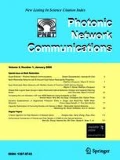Abstract
In this article, a genetic evolutionary algorithm is proposed for efficient allocation of wavelength converters in WDM optical networks. Since wavelength converters are expensive, it is desirable that each node in WDM optical networks uses a minimum number of wavelength converters to achieve a near-ideal performance. The searching capability of genetic evolutionary algorithm has been exploited for this purpose. The distinguished feature of the proposed approach lies in handling the conflicting circumstances during allocation of wavelength converters considering various practical aspects (e.g., spatial problem, connectivity of a node with other nodes) rather than arbitrarily to possibly improve the overall blocking performance of WDM optical networks. The proposed algorithm is compared with a previous approach to establish its effectiveness and the results demonstrate the ability of the proposed algorithm to efficiently solve the problem of Optimal Wavelength Converters Allocation (OWCA) in practical WDM optical networks.
Similar content being viewed by others
References
Mukherjee B. (1997). Optical Communication Networks. McGraw-Hill, New York
Ramaswami, R., Sivarajan, K.N.: Optical Networks: A Practical Perspective. Morgan Kaufmann Publisers (1998)
Roy, K., Naskar, M.K., Biswas U.: Adaptive dynamic wavelength routing for WDM optical networks. In: 3rd International conference on Wireless and Optical Communications Networks – 2006 (WOCN’06), IEEE Communication Society, Bangalore, India, pp. 1–4, 11–13 April 2006
Subramaniam S., Azizoglu M. and Somani A.K. (1996). All-optical networks with sparse wavelength conversion. IEEE/ACM Trans. Network. 4(4): 544–557
Lee K.C. and Li V.O.K. (1993). A wavelength-convertible optical network. IEEE/OSA J. Lightwave Technol. 11(5/6): 962–970
Ramamurthy, S., Mukherjee, B.: Fixed-alternate routing and wavelength conversion in wavelength routed optical networks. IEEE GLOBECOM 4, 2295–2302 (1998); Sydney, Australia
Subramaniam S., Somani A.K., Azizoglu M. and Barry R.A. (1999). The benefits of wavelength conversion in WDM networks with non-poisson traffic. IEEE Commun. Lett. 3(3): 81–83
Subramaniam, S., Azizoglu, M., Somani, A.K.: On the optimal placement of wavelength converters in wavelength-routed networks. Proc. INFOCOM 2, 902–909 (1998); San Francisco, CA, USA
Thiagarajan, S., Somani, A.K.: An efficient algorithm for optimal wavelength converter placement on wavelength-routed networks with arbitrary topologies. Proc. IEEE INFOCOM 2, 916–923 (1999); New York, NY, USA
Arora, A.S., Subramaniam, S.: Converter placement in wavelength routing mesh topologies. Proc. IEEE ICC 3, 1282–1288 (2000); New Orleans, LA, USA
Xiao G. and Leung Y.W. (1999). Algorithms for allocating wavelength converters in all-optical networks. IEEE/ACM Trans. Network. 7(4): 545–557
Gao S., Jia X., Huang C. and Du D. (2003). An optimization model for placement of wavelength converters to minimize blocking probability in WDM networks. IEEE/OSA J. Lightwave Technol. 21(3): 684–694
Jia, X., Du, D., Hu, X., Huang, H., Li, D.: Placement of wavelength converters for minimal wavelength usage in WDM networks. IEEE INFOCOM 3, 1425–1431 (2002); New York
Ding, Z., Hamdi, M.: On the management of wavelength converter allocation in WDM all-optical networks. IEEE GLOBECOM 5, 2595–2600 (2003); San Francisco, CA, USA
Gowda, S., Sivalingam, K.M.: Protection mechanisms for optical WDM networks based on wavelength converter multiplexing and backup path relocation techniques. IEEE INFOCOM 1, 12–21 (2002); New York
Frei, C., Faltings, B., Hamdi, M.: Resource allocation in communication networks using abstraction and constraint satisfaction. IEEE J. Select. Areas Commun. 23(2) (2005)
Roy, K.: A simple approach for optimal allocation of wavelength converters in WDM optical networks. In: 4th International Conference on Wireless and Optical Communication Networks’07 (WOCN 2007), Grand Hyatt, Singapore, pp. 1–5, 2–4 July 2007
Venugopal, K.R., Shivakumar, M., Kumar, P.S.: A heuristic for placement of limited range wavelength converters in all-optical network. Proc. IEEE INFOCOM 2, 908–915 (1999); New York, NY, USA
Yates, J., Lacey, J., Everitt, D., Summerfield, M.: Limited-range wavelength translation in all-optical networks. Proc. IEEE INFOCOM 3, 954–961 (1996); San Francisco, CA, USA
Tripathi, T., Sivarajan, K.: Computing approximate blocking probabilities in wavelength routed all-optical networks with limited-range wavelength conversion. Proc. IEEE INFOCOM 1, 329–336 (1999); New York, NY, USA
Ramaswami R. and Sasaski G. (1998). Multiwavelength optical networks with limited wavelength conversion. IEEE/ACM Trans. Network. 6(6): 744–754
Tachibana T. and Kasahara S. (2004). QoS-guaranteed wavelength allocation for WDM networks with limited-range wavelength conversion. IEICE Trans. Commun. E87-B(6): 1439–1450
Holland J.H. (1975). Adaptation in Natural and Artificial Systems. MIT Press, Cambridge
Horowitch, E., Sahani, S.: Fundamentals of Computer Algorithms. Galgotia, New Delhi
Horst, R., Pardalos, P.M. (eds.): Handbook of Global Optimization. Kluwer Academic Publishers (1995)
Goldberg D.E. (1989). Genetic Algorithms in Search Optimizations and Machine Learning. Addison Wesley, New York
Srinivas M. and Patnaik L.M. (1994). Genetic algorithm: a survey. IEEE Comput. Mag. 27(6): 17–26
Mukhopadhyay, A., Biswas, U., Naskar, M.K.: A genetic algorithm for traffic grooming in unidirectional SONET/WDM rings. IEEE India Annual Conference, INDICON, 2004, IIT, Kharagpur, India, pp. 252–255, 20–22 December 2004
Mukhopadhyay, A., Biswas, U., Naskar, M.K., Maulik, U., Bandyopadhyay S.: In: Olariu, S., Zomaya, A.Y. (eds.) Handbook of Bioinspired Algorithms and Applications, 1 edn. Chapman & Hall/CRC, 29 September 2005
Bäck, T., Fogel, D.B., Michalewicz, Z.: Handbook of Evolutionary Computation. Institute of Physics Publishing and Oxford University Press (1997)
Storn R. and Price K. (1997). Differential evolution—a simple and efficient adaptive scheme for global optimization over continuous spaces. J. Glob. Optim. 11(4): 341–359
Yao X., Liu Y. and Lin G. (1999). Evolutionary programming made faster. IEEE Trans. Evol. Comput. 3(2): 82–102
Tsui K.C. and Liu J. (2002). An evolutionary multiagent diffusion approach to optimization. Int. J. Artif. Intell. Pattern Recognit. 16(6): 715–733
Roy K. and Naskar M.K. (2007). Genetic evolutionary algorithm for static traffic grooming to SONET over WDM optical networks. J. Comput. Commun., Elsevier 30(17): 3392–3402
Author information
Authors and Affiliations
Corresponding author
Rights and permissions
About this article
Cite this article
Roy, K., Naskar, M.K. Genetic evolutionary algorithm for optimal allocation of wavelength converters in WDM optical networks. Photon Netw Commun 16, 31–42 (2008). https://doi.org/10.1007/s11107-008-0115-4
Received:
Accepted:
Published:
Issue Date:
DOI: https://doi.org/10.1007/s11107-008-0115-4




